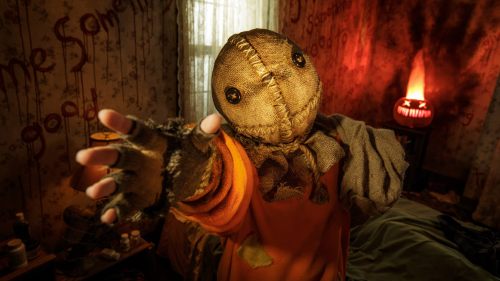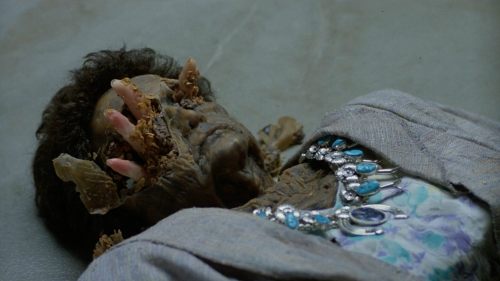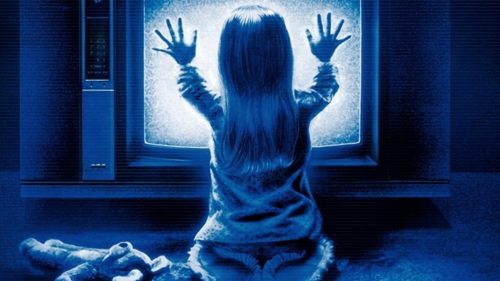THEY’RE (STILL) HERE: An Appreciation of POLTERGEIST
The scene in Poltergeist that left the biggest impression on me isn’t actually in the movie. I saw the film early, around five years old, and recall avoiding subsequent airings on TV for a while because I was too frightened of "the thing on the wall." This refers to the reddish monster with blackened eyes and goopy claw hands that comes out of the wall and tries to grab the Freelings -- and if you’re thinking “that’s not in the movie,” well, you’re right. When I finally mustered up the courage for a revisit around six years later, I discovered that no such thing actually appeared in the film; best I can figure, the giant hole in the wall near the film's conclusion (which does have a tentacle type thing protruding from it) merely served as an inspiration for a nightmare involving the aforementioned, completely made up monster. Luckily, by then I was also afraid of clowns (a fear that was probably seeded by the film) so Tobe Hooper and Steven Spielberg's classic still scared me.
And yes, ownership belongs to both. The reason people can't ever seem to agree on the real director of the movie is that it’s a clear collaboration, as for every unmistakable Spielberg imprint, there's another of Hooper's. Do you think Spielberg was the one to cast Lou Perryman, a crew member from Tobe Hooper's earlier work? The evidence is pretty clear: Spielberg wanted to direct the film himself but couldn't due to his ET duties, and as writer and producer the film was likely to resemble his other films no matter who was listed as a director. Perhaps he was a bit more hands-on than a producer normally would be (it's interesting that several of the behind the scenes stories involving frightened cast members end with "but Steven Spielberg jumped in and calmed them down," as that would traditionally be the director's role), but it's also important to note that Hooper doesn't have a signature style like some of his contemporaries. Someone with a little more "auteur" style like Carpenter probably would have left more fingerprints on the film, sure -- but let's not forget that if there's one thing uniting most of Hooper's filmography, it's a bit of kookiness, and that's part of what makes Poltergeist so great.
On that note, no one is kookier than Zelda Rubinstein as Tangina, and she leaves such an impression (and along with Heather O'Rourke as Carol Anne was the only cast member to appear in all three films) that it's almost a surprise in hindsight that she's actually only in the film for about twenty minutes. There are only forty minutes left when she makes her first appearance, and she exits after declaring the house clear -- which turns out to be wrong, with another big setpiece to go. She's also less weird in this entry, where the sequels made her a typically spooky old lady speaking in mumbo jumbo more often than not. One of my favorite tension-breakers, of several, in the film is when Tangina argues with Diane (JoBeth Williams) about who should go into the portal, with Diane pointing out she's just as qualified to go into it as neither of them have ever done it before. Tangina simply replies, "You're right, you go." (That the camera stays on her face the entire time instead of cutting to Williams for her response adds immensely to the humor value).
But obviously one character with limited screentime does not make the film the classic that endures (and, goes without saying, offers more excitement and tension on your fiftieth viewing than the tepid remake could offer with one). It's the pacing and structure that really sells it, with the movie giving us a scare in its first scene. It's something that might even be forgotten; when you think of Poltergeist's opening scenes you'll probably remember the lighthearted, mostly daytime scenes -- the guys watching the football game that keeps getting interrupted by Mr. Rogers, oldest daughter Dana telling off the construction guys, Steven and Diane smoking a joint (with the former reading a Reagan biography for good measure). It seems like the sort of movie that would hold off on the horror until we get to know our heroes, but nope -- there's something amiss in its first frames, with Carol Anne talking to the TV before we've even learned everyone's names. And even with the trauma of a child disappearing fairly early in the film, the script never abandons the deadpan humor that makes it so fun -- Steven's reaction to the psychic guy's proud claims of seeing a toy car moving at a speed of 1 foot per hour before showing him the insanity occurring nonstop in his kids' bedroom will never fail to make me laugh out loud.
And, of course, the clown. The goddamn clown. The genius in Poltergeist is that they show the doll a couple of times but give you plenty of other things to worry about, so you almost forget about it by the time its sequence revs up. No one involved with the remake clearly understood this, and so it's pretty much the first big thing that happens, resulting in a scare-free sequence that's long forgotten by the time the movie wraps up an hour later. In turn, the movie itself will be forgotten by next year, while the 1982 original keeps traumatizing kids and adults alike for generations to come. Even with scenes that aren’t actually in it.
This was originally published in the September issue of Birth.Movies.Death. magazine. See Poltergeist at the Alamo Drafthouse this month.



